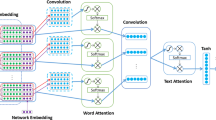Abstract
User attribute classification plays an important role in the Internet advertising, public opinion monitoring. While the user points of interest prediction helps the online social media services creating more value. In this paper, aiming at solving the user attributes classification tasks we combine the feature engineering and deep Learning method to reach a higher rank. User attribute classification task is divided into two sub-tasks, in sub-task one, we use the user’s POI (point of interest) check-in history and popular POI location information to predict the next POI that user may visit the future. Sub-task 2 needs to predict the gender of the user. We use the Stacking method to carry out the feature fusion method to complete the feature extraction, based on the output of the logistic regression model then features will be sent to XGBoost model to perform the prediction. In addition, we also used the Convolution neural network model to dig out the user tweets information. Here we replace the conventional Max Pooling method with Attention Pooling in order to minimum the information lost in neural network training. Finally, two methods are given to give a more accurate result.
Access this chapter
Tax calculation will be finalised at checkout
Purchases are for personal use only
Similar content being viewed by others
References
Chan, C.C., Lin, Y.C., Chen, M.S.: Recommendation for advertising messages on mobile devices. In: International Conference on World Wide Web, pp. 235–236. ACM (2014)
Yang, X., Deng, T., Guo, Z., et al.: Advertising keyword recommendation based on supervised link prediction in multi-relational network. In: Proceedings of the 26th International Conference on World Wide Web Companion. International World Wide Web Conferences Steering Committee, pp. 863–864 (2017)
Wang, J., Wang, B., Duan, L., et al.: Interactive ads recommendation with contextual search on product topic space. Multimedia Tools Appl. 70(2), 799–820 (2014)
Gong, J., Gao, X., Song, Y., Cheng, H., Xu, J.: Individual friends recommendation based on random walk with restart in social networks. In: Li, Y., Xiang, G., Lin, H., Wang, M. (eds.) SMP 2016. CCIS, vol. 669, pp. 123–133. Springer, Singapore (2016). https://doi.org/10.1007/978-981-10-2993-6_10
Wang, X., Wang, Y.: Improving content-based and hybrid music recommendation using deep learning. In: Proceedings of the 22nd ACM International Conference on Multimedia, pp. 627–636. ACM (2014)
Shi, Y., Larson, M., Hanjalic, A.: Collaborative filtering beyond the user-item matrix: a survey of the state of the art and future challenges. ACM Comput. Surv. (CSUR) 47(1), 3 (2014)
Liu, H., Hu, Z., Mian, A., et al.: A new user similarity model to improve the accuracy of collaborative filtering. Knowl.-Based Syst. 56, 156–166 (2014)
McGee, J., Caverlee, J., Cheng, Z.: Location prediction in social media based on tie strength. In: Proceedings of the 22nd ACM International Conference on Information & Knowledge Management, pp. 459–468. ACM (2013)
Liu, X., Liu, Y., Aberer, K., et al.: Personalized point-of-interest recommendation by mining users’ preference transition. In: Proceedings of the 22nd ACM International Conference on Information & Knowledge Management, pp. 733–738. ACM (2013)
van de Loo, J., De Pauw, G., Daelemans, W.: Text-based age and gender prediction for online safety monitoring. Int. J. Cyber-Secur. Digit. Forensics (IJCSDF) 5(1), 46–60 (2016)
Bamman, D., Eisenstein, J., Schnoebelen, T.: Gender identity and lexical variation in social media. J. Socioling. 18(2), 135–160 (2014)
Antipov, G., Berrani, S.A., Dugelay, J.L.: Minimalistic CNN-based ensemble model for gender prediction from face images. Pattern Recogn. Lett. 70, 59–65 (2016)
Levi, G., Hassner, T.: Age and gender classification using convolutional neural networks. In: Proceedings of the IEEE Conference on Computer Vision and Pattern Recognition Workshops, pp. 34–42 (2015)
Kim, Y.: Convolutional neural networks for sentence classification. arXiv preprint arXiv:1408.5882 (2014)
Mnih, V., Heess, N., Graves, A.: Recurrent models of visual attention. In: Advances in Neural Information Processing Systems, pp. 2204–2212 (2014)
Er, M.J., Zhang, Y., Wang, N., et al.: Attention pooling-based convolutional neural network for sentence modelling. Inf. Sci. 373, 388–403 (2016)
Acknowledgments
This work is partially supported by grant from the Natural Science Foundation of China (Nos. 61632011, 61562080, 61602079), the Fundamental Research Funds for the Central Universities (DUT16ZD216, DUT17RC(3)016).
Author information
Authors and Affiliations
Corresponding author
Editor information
Editors and Affiliations
Rights and permissions
Copyright information
© 2018 Springer International Publishing AG
About this paper
Cite this paper
Wen, D., Yang, L., Li, H., Guo, K., Fei, P., Lin, H. (2018). NLPCC 2017 Shared Task Social Media User Modeling Method Summary by DUTIR_923. In: Huang, X., Jiang, J., Zhao, D., Feng, Y., Hong, Y. (eds) Natural Language Processing and Chinese Computing. NLPCC 2017. Lecture Notes in Computer Science(), vol 10619. Springer, Cham. https://doi.org/10.1007/978-3-319-73618-1_52
Download citation
DOI: https://doi.org/10.1007/978-3-319-73618-1_52
Published:
Publisher Name: Springer, Cham
Print ISBN: 978-3-319-73617-4
Online ISBN: 978-3-319-73618-1
eBook Packages: Computer ScienceComputer Science (R0)




